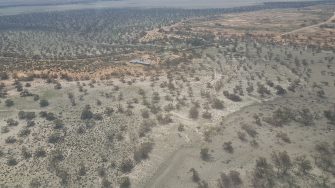
Date: Monday, October 12, 2020
Project: Eastern Australian Waterbird Survey
Observers: Richard Kingsford UNSW, Paul Wainwright DEWHA
Pilot: James Barkell NSW National Parks & Wildlife Service DPIE
Back again to head west to Broken Hill today. Flying out over the Blue Mountains was wonderful in the morning. The fire scar was all too apparent but most of the trees were resprouting after the devastating fires earlier this year. Time will tell how good the recovery is.
Our first survey was over Burrendong Dam which was nearly empty last year. Good rains in the catchment had put a lot of water into the dam, nearly half full, still a long way off full. The Macquarie Marshes which depend on water from up here in the catchment need a full dam and then some filling for widespread flooding. The water level was still well short of the spillway. As usual, even though there was quite a lot of water in the dam, there weren’t that many waterbirds. Just the odd pelican and cormorant.
From here was a quick flight down the Macquarie River with a few small flocks of wood ducks and the odd pair of black ducks and on to refuel in Dubbo, among the flocks of sulphur crested cockatoos.
We then headed west. It was so refreshing to see the carpet of green paddocks, interrupted by gashes of purple coloured Pattersons curse. It makes for a welcome change from the last few years.
Most of the small dams had water although not all of the swamps were full. As we headed west some of the small swamps had filled from local rainfall.
One of the major distributary systems of the Darling River, when it has a major flood, was the Tallywalka Creek system which runs into a series of large freshwater lakes when it flows. But the earlier flood in the Darling was not nearly enough to flood this area.
We reached the Menindee Lakes which we surveyed systematically, north to south, with two counts on each lake. Not all the lakes were full. We separately counted the northern Menindee Lakes for the Murray-Darling Basin Authority. Lake Malta was dry but Lakes Balaka, Bijijie, Tandure, Wetherill and Pammamaroo all had water.
The density of waterbirds was low. They only really get going for large numbers of waterbirds when the lakes are drying. Today, there were just a few teal, pink-eared duck, pelicans, cormorants and swans. In total there were probably no more than a hundred or so waterbirds on this massive complex of wetlands.
Lakes Menindee and Cawndilla which lie in our survey band were both dry and so there were only a few wood ducks on the river to count here.
We ended the survey flying along the Darling River which was low again. There were no waterbirds along the section that we flew. Kinchega National Park with the woolshed in the foreground looked very dry.
We finished up in Broken Hill for the night.
Blog by Richard Kingsford
